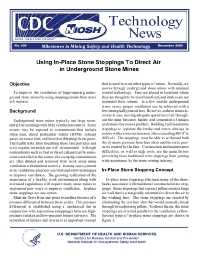Mining Publication: Technology News 500 - Using In-Place Stone Stoppings to Direct Air in Underground Stone Mines
Original creation date: December 2002
Underground stone mines typically use large room-and-pillar openings with little ventilation control. Stone miners may be exposed to contaminants that include silica dust, diesel particulate matter (DPM), exhaust gases, nuisance dust, and face shot (blasting) fume gases. The health risks from breathing these fine particles and toxic organic materials are well documented. Although contaminants such as dust or diesel exhaust can be somewhat controlled at the source, the escaping contaminants are often diluted and removed from work areas using ventilation with minimal controls. In many cases, current mine ventilation practices use trial-and-error techniques to improve ventilation. The growing realization of the importance of a healthy work environment along with increased regulations will require many stone mines to implement new ways to improve ventilation. In-place stone stoppings are one option. Mine air flows from one point to another because of a pressure differential between those points. This pressure differential is established using a mechanical fan in conjunction with separations (stoppings) between high-pressure (intake) and low-pressure (return) airways. The separation of intakes and returns is an important concept that is used in most other types of mines. Normally, air moves through underground stone mines with minimal control technology. Fans are placed in locations where they are thought to be most beneficial, and intakes are not separated from returns. In a few smaller underground stone mines, proper ventilation can be achieved with a few strategically placed fans. However, as these mines in-crease in size, moving adequate quantities of air through-out the mine becomes harder, and separation of intakes and returns becomes a problem. Building traditional mine stoppings to separate the intake and return airways in entries with a cross-section area often exceeding 800 ft 2 is difficult. The stoppings must be able to withstand both the dynamic pressure from face shots and the static pressures created by the fans. Construction and maintenance difficulties, as well as high costs, are the main factors preventing these traditional mine stoppings from gaining wide acceptance by the stone mining industry.
Authors: RH Grau, RB Krog
Technology News - December 2002
NIOSHTIC2 Number: 20022370
U.S. Department of Health and Human Services, Public Health Service, Centers for Disease Control and Prevention, National Institute for Occupational Safety and Health, Technology News 500, 2002 Dec :1-2
See Also
- A Computer Software Program that Estimates Air Quantity Requirements in Large Opening Stone Mines
- Degasification System Selection for U.S. Longwall Mines Using an Expert Classification System
- Development of New Protocols to Evaluate the Transverse Loading of Mine Ventilation Stoppings
- Effects of Weak Bands on Pillar Stability in Stone Mines: Field Observations and Numerical Model Assessment
- Explosion Effects on Mine Ventilation Stoppings
- Pillar and Roof Span Design Guidelines for Underground Stone Mines
- Pillar Stability Issues Based on a Survey of Pillar Performance in Underground Limestone Mines
- Pillar Strength and Design Methodology for Stone Mines
- Practical Techniques to Improve the Air Quality in Underground Stone Mines
- Technology News 518 - Super Stopping: A Permanent Solid Stopping for Directing Ventilation Airflows in Large-opening Metal/Nonmetal Mines
- Content source: National Institute for Occupational Safety and Health, Mining Program


 ShareCompartir
ShareCompartir
